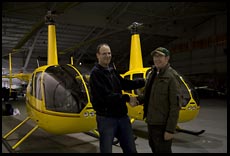

|
Preparing for your first helicopter lessonat East Coast Aero Club; updated June 2020 |
From the Helicopter Handbook, please read the following:
Lift is a function of airspeed and angle of attack, the angle between an airfoil and the relative wind. Imagine riding in a car and putting your hand out the window. If you tilt your hand up a little bit, it catches the wind and you feel a force pushing your arm up. The force will increase if the car is moving faster and the force will increase if you tilt your hand more.
A little Cessna airplane works more or less the same way as your hand out the car window. If the airplane goes faster with the wing at the same angle, more lift is generated and the airplane rises. If the airplane slows down and the pilot wishes to hold altitude, the pilot needs to pitch up so that the wings achieve a higher angle of attack and the same amount of lift is generated. Beyond some angle, it isn't possible to continue to generate more lift with additional tilt. This is called the "stalling angle of attack" and it limits airplanes to flying no slower than about 50 mph. You can't fly with your wings perpendicular to the ground! That's why the helicopter was invented. We take the same basic wing shape from the Cessna, spin it around at 400 rpm with an engine, and now we always have airspeed over the wing even when the pilot and passengers are stationary in a hover.
The Robinson flight controls are directly connected to pitch links. Even with the engine stopped and the helicopter sitting in a hangar, pulling up on the collective pitch control will twist the blades to increase the pitch angle. The cyclic pitch control will tilt the swash plate so that the blade pitch angle varies as the rotor system rotates.
The collective pitch control will directly twist the blades. If the throttle were not adjusted simultaneously, the rotor RPM would rise and fall as drag decreases and increases from the varying angle. This is why Robinson puts a correlator and governor into their helicopter and why it is important not to grip the throttle tightly while flying. The pilot can overpower and interfere with the automatic systems. When in doubt, adjust the collective with two fingers and/or grasp it behind the throttle (your instructor will show you this before flight).
Once in the air, how do we get the helicopter to turn around? As you've no doubt experienced on commercial airline flights, a pilot turns an aircraft by putting the aircraft into a bank and then holding that bank. How can we get the helicopter to bank left? The cyclic pitch control, which will be in your right hand, is popularly understood as a means of tilting the rotor system. This doesn't make sense because (1) the rotor system is heavy and spinning fast and, like a gyroscope, resists being titled, and (2) once in the air, there is nothing for the helicopter to push against in its effort to tilt the rotor system. What we want is to generate more lift on one side of the rotor disk and let the rotor system fly itself into a new position. The helicopter is hanging underneath and will follow. The cyclic works by increasing the pitch angle on the blades as they rotate around part of the disk and then decreasing it as they come around to the other side.
There are two ways to understand the tail rotor. One is that, with nothing to push against, the torque of the engine in swinging the blades around in one direction will cause the main body of the helicopter to rotate in the opposite direction ("for every action there is an equal and opposite reaction"). Another way to understand it is via conservation of angular momentum. The helicopter in the hangar wasn't spinning. If you start the blades spinning somehow, the whole system can only get back to its original net angular momentum of zero if the main body of the helicopter spins opposite. Don't worry if this seems like Physics 101; when you're in the helicopter it will all be natural and intuitive. If the nose is turning left, push on the right pedal.
Similarly, if you lean forward or back in your office chair you don't say "this is a whole new job." But in a helicopter, trying to hover, pitching the helicopter forward a bit will start the helicopter moving forward.
More information: our standard page for prospective helicopter students.
What function do the anti-torque pedals serve when doing a turn at 70 knots, 500' above the ground?
Looking at Figure 2-9 of the Rotorcraft Flying Handbook, if a helicopter has enough power to hover, does it have enough power to fly and climb? (Keep in mind that the "speed" on the x-axis in the figure is the indicated airspeed of the helicopter body, where hover=0; the airspeed of the rotating wing is roughly constant, which is why it is possible to have significant lift and drag even when the airspeed of the "helicopter" is zero.)
Does the blade stall at a lower angle of attack when the weather is hot and humid?
The Robinson R44 has a switch on the cyclic to disable the hydraulics. What will happen to the controls when the hydraulics are turned off?
Suppose that you're flying along at 60 knots, straight and level. Can you climb while holding the same airspeed? If so, which controls would you adjust and in what order?
Why is it necessary to get an altimeter setting from the Hanscom Tower ATIS (prerecorded information, typically updated hourly)? Why wouldn't the altimeter always read the correct altitude above sea level?
How many runways are there at Hanscom Field? In what direction is each oriented?